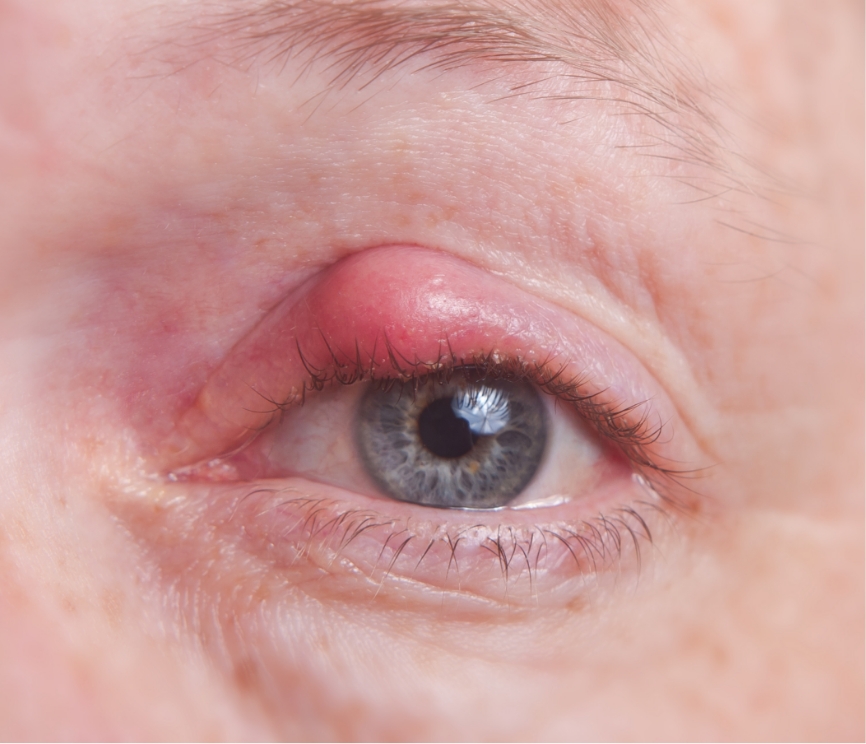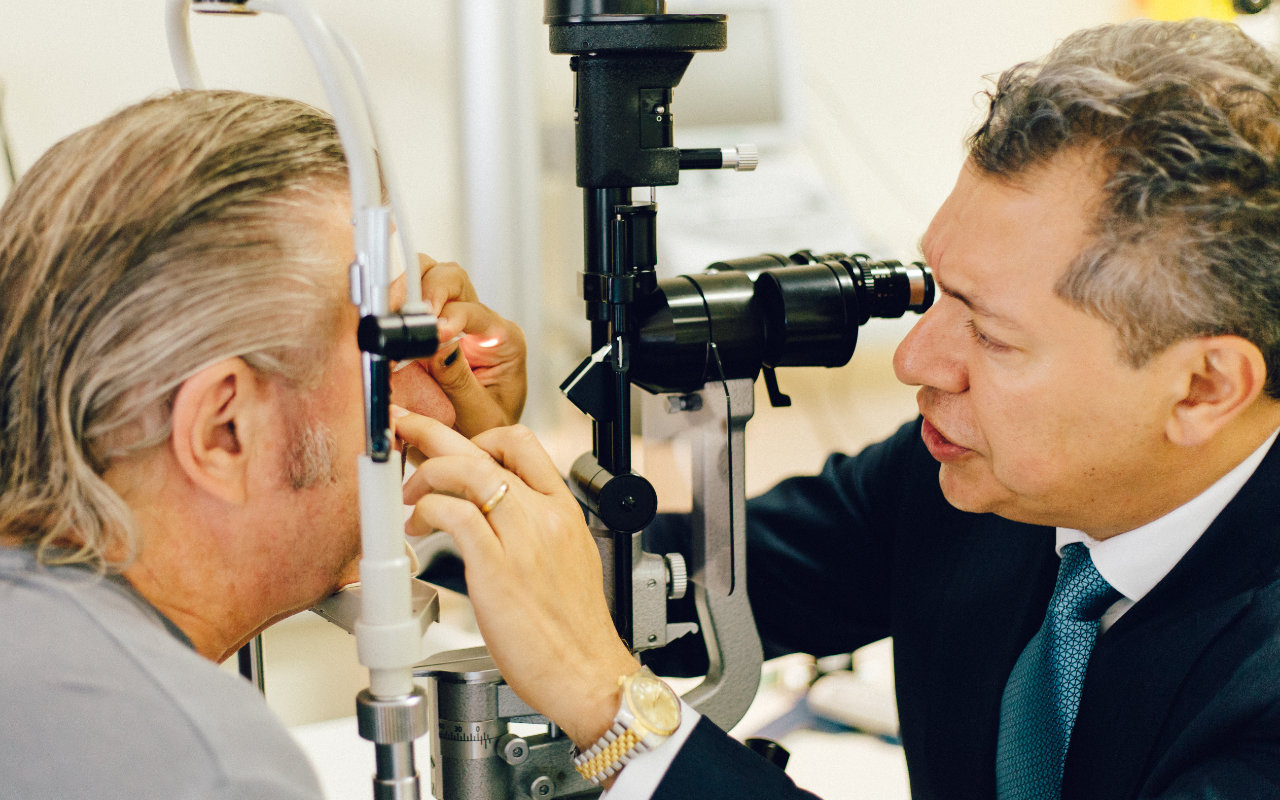
Chalazion
Consultant-led treatment from Mr Hooman Sherafat, with precision care and personal support at every step.
Book a Consultation Scroll to learn more

Overview
Chalazion at The London Eye Clinic
A chalazion (also known as a meibomian cyst) is a cyst in the eyelid. A common condition, it often but not always occurs due to inflammation around the opening of the oil glands at the base of the eyelashes.
Symptoms
Signs of Chalazion
- A small, firm lump within the eyelid
- If the lump is large enough, it can press on the eyeball causing blurred vision
- A Chalazion can interfere with tear production, leading to an irritable or watery eye
- The lump is often painless, though it can cause mild irritation or tenderness, especially when it first appears.

About
About Chalazion
What is Chalazion?
A chalazion (also known as a meibomian cyst) is a cyst in the eyelid. A common condition, it often but not always occurs due to inflammation around the opening of the oil glands at the base of the eyelashes. The inflammation (called blepharitis) is caused by sensitivity to a common bacteria found on the skin. When the opening of the small oil glands around the lashes become blocked by inflammation, a small tender swelling occurs in the eyelid, known as a chalazion. The chalazion will often vary in size over a few weeks and can discharge spontaneously or disappear after hot compresses and lid cleaning. A small proportion of the chalazia will remain for weeks or months in the lid, as a non-tender lump; this can be safely left to get better by itself. Sometimes the chalazion may cause a spreading infection along the surface of your lid, which might need a course of antibiotics by mouth, but this is rare.
There are some measures you can take which may help resolution. These include:
Warm compress: Boil some water and let it cool a little or use water from the hot tap. Soak cotton wool or a clean flannel in the warm (but not boiling) water, squeeze it out and gently press onto your closed eyelids for two to three minutes at a time. Alternatively, you can use heated eye masks
Massage: Starting at the skin crease, gently massage the upper lid downwards to the lashes. The lower lid should be massaged upwards towards the lashes. This may release the contents of the cyst, which means further treatment will not be necessary.
If the chalazion does not respond to the first stage of the treatment, it can be drained, by a procedure carried out in outpatients under local anaesthesia referred to as an “Incision & Curettage” (I&C), although it can also be left alone.
When to Seek Medical Help?
Signs of Infection: Look for increased redness, significant swelling, pus, or fever.
Severe Pain: While usually painless, severe or recurring pain can signal an infection.
Persistent Symptoms: If symptoms persist or worsen after a few days.
Treatment
Information on the procedure
The procedure which is referred to as and Incision & Curettage (I&C), is carried out as an outpatient procedure in clinic and can often be offered on the same day as the consultation.
After an injection of local anaesthetic, the lid is everted, and a small incision is made in the under surface of the cyst and the contents expressed (scraped). Occasionally the procedure needs to be carried out through the front skin of the eyelid or the eyelid skin can break if already affected by the inflammation from the cyst. The eye is then padded for a few hours and you are provided with a course of antibiotic drops or ointment.
- Commonly, the lid can be swollen or bruised for a few days after the procedure
- You can wash your face and eye and shower as normal
- You may experience a foreign body sensation in the eye, as though there is an eyelash or something under the eyelid
- You can experience some mild intermittent discharge, which may be bloodstained. If present, these symptoms usually subside within a few days
- You should not wear a contact lens in the treated eye for at least one week after an I&C
- You may feel a small residue of the swelling, which may take a little longer to settle
Even if the treatment has not worked, we would wait at least six weeks before considering a repeat incision and curettage as many can continue to settle during this period.
This is generally a safe procedure, but no intervention is risk free. The risks of I&C are small but include failure, recurrence, corneal abrasion, infection, bleeding, lash loss (very rare), and breakage through the skin overlying the cyst if already thinned, crusted and scabbed due to partial spontaneous discharge. This usually heals very well.

Patient Journey
What you can expect under our care

Consultation & Examination
The operation is usually performed under a local anaesthetic that is injected in your eyelid as a daycase. Mr Sherafat will discuss the options with you and recommend the best form of anaesthesia for you.
Your Procedure
After an injection of local anaesthetic, the lid is everted, and a small incision is made in the under surface of the cyst and the contents expressed (scraped).
Recovery & Follow-up
The eye is then padded for a few hours and you are provided with a course of antibiotic drops or ointment.
Frequently Asked Questions
Common questions we are asked
Got a question that’s not covered here?
Just get in touch with our friendly team we’re happy to help and always here to talk through your options.
Contact usUsually yes; occasionally there are reasons this may not be offered on the day. These include the procedure, is not suitable for the outpatient minor-ops room or the minor ops room is not available. If you are interested in having your treatment on the day, it would be helpful if you would contact Mr Sherafat’s PA. It would be preferable not to drive on the day.
You do not usually need to discontinue any medication. It would be helpful if you do not wear make up on the day. Depending on the location and size of the lesion, it would be advisable not to plan any important social engagements for the following 7 days. You are advised to refrain from wearing your contact lens for at least 7 days after your treatment.
Your eye would probably be padded for about two hours after the procedure, so you would be advised not to drive during that period.
Simply visit our contact page and use any of the methods on that page to contact us to get a consultation booked in at a time and location to suit you.
Ready to book a consultation?
Whether you’re looking for more information or want to take the next step, our friendly team is here to help and happy to talk things through with you.
Contact us
"*" indicates required fields
Why Choose Us
Reasons Our Patients Trust Us with their eyes.
Our patients know that they are cared for and listened to. We take the time to provide clear information about all available options, along with the benefits and risks of each. This approach gives every patient the confidence to make informed choices about their treatment, knowing they are supported every step of the way.
Putting the patient first
At The London Eye Clinic, patient care is at the heart of everything we do. Hooman is known for his caring, transparent approach, taking the time to understand each person’s individual needs and creating treatment plans that are compassionate, thorough, and patient-centred . From leading the Best Interest Ophthalmology Service for patients with learning difficulties to offering clear guidance on surgical and non-surgical options, his focus is always on doing what’s right for the patient.
Advanced eye care treatment
With extensive training at leading London hospitals, including St George’s, Guy’s and St Thomas’, and Moorfields. Hooman brings advanced expertise in oculoplastic, lacrimal, and reconstructive surgery alongside general ophthalmology. The London Eye Clinic offers a wide range of treatments, from cataract operations to delicate eyelid procedures, delivered with the latest techniques and the highest standards of care. Whether routine or complex, every treatment is carried out with precision and attention to detail.
Over 20 years of experience
Since qualifying in 1992, Hooman has gained over two decades of experience treating thousands of patients. His work is recognised not only in the UK but also internationally, performing cataract operations in Ghana, Bangladesh, and Burma, and being invited to the House of Lords in recognition of his support for the visually impaired. This depth of experience gives patients confidence that they are in safe, capable hands.

Testimonials
What Are Patients Saying?
Real stories from patients who trusted their eyes to Hooman Sherafat.
